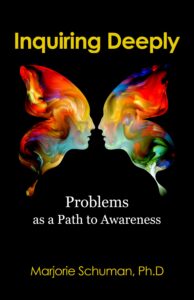Announcing the publication of INQUIRING DEEPLY: PROBLEMS AS A PATH TO AWARENESS

I am pleased to announce that my new book has now been published and released. I hope that the illustration I chose for the cover (above) will attract your interest in reading it. [Available on Amazon & wherever books are sold)
https://www.amazon.com/dp/B0CKGYC1H4
Here is the summary I wrote for the back cover:
Problems are the leading edge or horizon of change in our lives. They have a role in our minds analogous to the role of pain in the body: they call our attention to what we most need to see. Like an extended conversation that takes place both within ourselves and in the external world simultaneously, inquiring deeply about problems shows us where we have shut down, where we need to wake up, and where we need to grow.
Weaving together the insights of psychoanalysis with the wisdom of Buddhist psychology, in this book of essays Marjorie Schuman illuminates some of our common human predicaments and articulates what can be learned when we use self-reflection and deep meditative inquiry to unpack psychological issues and problems.
Through the process of asking questions and listening deeply for answers, Inquiring Deeply consciously engages our experience of problems in an ongoing way which invites the wisdom within them to unfold.
As I have said elsewhere, posing inquiry questions is a powerful act in and of itself, one which provides a kind of psychospiritual scaffolding which can support growth and the emergence of new experience. The awareness practice I call “inquiring deeply” grew out of my commitment to grow with and from what I discovered in my emotional life. It has served me well.
Inquiry, I have come to see, unfolds organically as a function of engaging in deep conversation with others about what is most important to us. Communication is a generative act; no one knows in advance what will come out of a conversation. It is more of an event that happens to us than something we “do”, and it allows something to “emerge” that henceforth exists. Ultimately, it is the climate of relationship in communication that allows transformative change to come into being.
This potential is what the writer Ursula Le Guin has called “the beauty and terror of conversation, that ancient and abiding human gift.” In every act of communication, she tells us, there is “the possibility of planting into another mind a seed sprouted in ours and watching it blossom into a breathtaking flower of mutual understanding.”
May reading this book plant many such seeds in your mind.
Marjorie Schuman
Santa Barbara, CA
10-02-23
